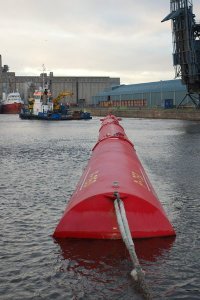Bloomberg via The Economic Times, February 2, 2009
 LONDON: Three decades ago, engineer Peter Fraenkel created an underwater turbine to use river power to pump water in Sudan, where he worked for a charity. Civil war and a lack of funding stymied his plans. Now, his modified design generates electricity from tides off Northern Ireland.
LONDON: Three decades ago, engineer Peter Fraenkel created an underwater turbine to use river power to pump water in Sudan, where he worked for a charity. Civil war and a lack of funding stymied his plans. Now, his modified design generates electricity from tides off Northern Ireland.
“In the 1970s, the big snag was the market for that technology consisted of people with no money,” said Fraenkel, the 67-year-old co-founder of closely-held Marine Current Turbines. “Now it’s clear governments are gagging for new renewable energy technology.”
MCT last year installed the world’s biggest grid-connected tidal power station in Strangford Lough, an Irish Sea inlet southeast of Belfast. The SeaGen project’s two turbines, which cost 2.5 million pounds ($3.6 million), can produce as much as 1.2 megawatts of electricity, enough to power 1,140 homes. The company is one of more than 30 trying to tap tidal currents around the world, six years after the first project sent power to the grid.
Investors may pump 2.5 billion pounds into similar plants in Europe by 2020 as the European Union offers incentives for projects that don’t release carbon dioxide, the gas primarily blamed for global warming. In the US, President Barack Obama plans to increase tax breaks for renewable energy.
“Tidal energy has an enormous future, and the UK has a great resource” if construction costs come down, said Hugo Chandler, renewable energy analyst at the Paris-based International Energy Agency, which advises 28 nations. “It’s time may be just around the corner.”
While tides are a free source of energy, generating power from them is three times more expensive than using natural gas or coal over the life of a project, according to the Carbon Trust, a UK government-funded research unit.
Including capital expenses, fuel and maintenance, UK tidal current power costs 15 pence per kilowatt hour, compared with 5 pence for coal and gas and 7 pence for wind, the trust says.
Designing equipment to survive in salty, corrosive water and installing it in fast-moving currents boosts startup costs, said MCT Managing Director Martin Wright, who founded the Bristol, England-based company with Fraenkel in 2002. MCT raised 30 million pounds for SeaGen and pilot projects, he said, declining to break out the expenses.
Gearboxes and generators have to be watertight. The machinery must withstand flows up to 9.3 knots (10.7 mph) in Strangford Lough, which exert three times the force of projects that harness wind at similar speeds, Fraenkel said.
“The forces you’re trying to tap into are your enemy when it comes to engineering the structure,” said Angela Robotham, MCT’s 54-year-old engineering chief.
The project consists of a 41-meter (135-foot) tower with a 29-meter crossbeam that is raised from the sea for maintenance. Attached to the beam are two rotors to capture incoming and outgoing flows. The turbines convert the energy from tidal flows into electricity, differing from more established “tidal range” technology that uses the rise and fall of water.
Positioned between the North Sea and Atlantic Ocean, the British Isles have about 15% of the world’s usable tidal current resources, which could generate 5% of domestic electricity demand, the Carbon Trust estimates. Including wave power, the ocean may eventually meet 20 percent of the UK’s energy needs, the government said in June.
OpenHydro, a closely held Dublin company, linked a donut-shaped device with less than a quarter of the capacity of SeaGen to the grid at the European Marine Energy Centre in Orkney, Scotland, last May.
Read Full Post »
 Edinburgh-based Pelamis Wave Power has won an order from UK renewable energy generator E.On for the next generation Pelamis Wave Energy Converter, known as the P2.
Edinburgh-based Pelamis Wave Power has won an order from UK renewable energy generator E.On for the next generation Pelamis Wave Energy Converter, known as the P2.
